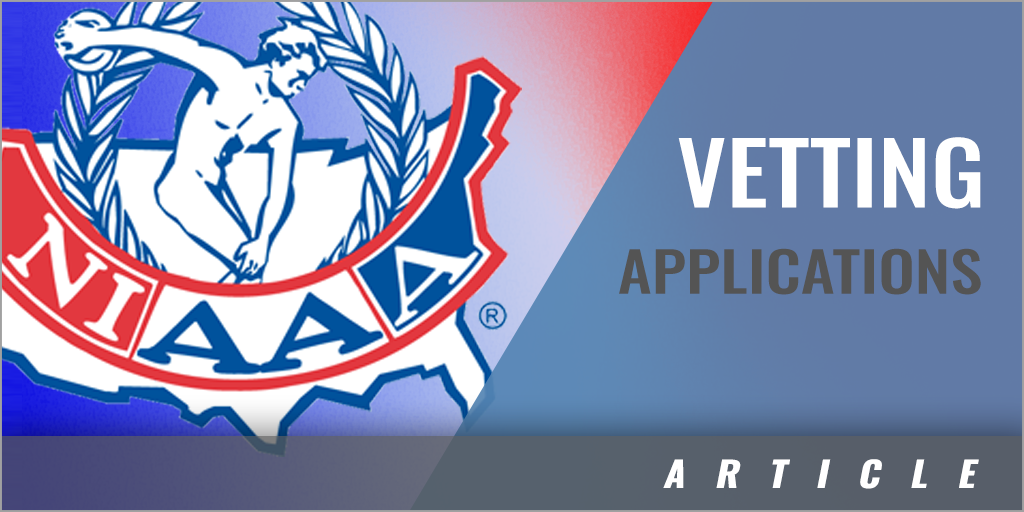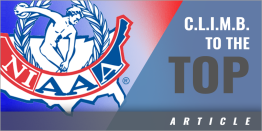|
By: Gary Stevens, Athletic Administrator - Thornton Academy (Saco, Maine) In today's American high schools, arguably the most important duty performed by administrative personnel is the supervision and evaluation of classroom teachers. Unfortunately, the time, energy, and effort required to ensure a safe learning and working environment and to address state initiatives may preclude school leaders from fully addressing this critical task. The best laid plans and intentions to visit classrooms and observe teacher performance can be quickly waylaid by an emergency or other situation requiring immediate attention. What should be a non-negotiable part of a school leader's daily routine is frequently relegated to the back burner. Similarly, those individuals placed in charge of high school athletic programs are assigned the responsibility of overseeing the work of paid and volunteer coaches who work directly with students. Although the classroom remains where "the rubber hits the road" in American schools, the gymnasiums and playing fields that dot their campuses are equally important centers of learning. The education-based athletic coach is charged with imparting life lessons about leadership, responsibility, and accountability that complement the academic skills (reading, writing, mathematics) taught in the classroom. The school's athletic director – the "coach of coaches" - serves a critical role of ensuring that those under his or her watch are meeting their responsibilities in offering the leadership, mentoring, and example required of a person entrusted with coaching. The work of supervising and evaluating coaches begins in the hiring process. Hiring coaches in today's educational environment is more difficult than ever. Although there was a time when schools hired classroom teachers who had an appetite or experience in working in co-curricular programs, that trend is a distant memory. Today's athletic directors are witnessing a dearth of applicants for those openings that arise, even for head coaching positions. Many of the applicants who do express an interest in coaching at the high school level have their roots in the world of club athletics, which operates under a different philosophy than education-based activities. Regardless of this challenging environment and the numerous obstacles that they face in finding the right candidate for each vacancy, high school athletic administrators should develop protocols and procedures for performing this part of their role. Furthermore, these processes for advertising, vetting, and filling positions within their districts should be (a) consistent with the hiring policies for other openings; (b) compliant with all state and federal laws; and (c) reviewed and approved by supervising administration. An athletic director should never act as a maverick, but instead be the consummate team player when it comes to filling those vacancies. Spreading the Word When a coaching vacancy occurs, schools need to find effective methods for communicating the opening and attracting the highest quality candidates. Many public-school systems, as a result of contractual agreements with teacher organizations, require that positions be advertised internally through school- or district-based posting for a period prior to the use of methods that may reach non-school personnel. If no quality internal candidates exist (or are interested), many athletic directors resort to advertising the position(s) to the public by using other means, including:
The advertisement should be carefully crafted to include all pertinent information, including what documentation is required of the candidate. Minimally, athletic administrators should insist that applicants submit a cover letter, a current and relevant resume, and the names of any references. A date upon which a successful candidate will be hired (if possible) can be listed. In addition, it is a good practice to require candidates for co-curricular positions to complete a standard school district job application that includes a section detailing recent jobs held by that applicant. In many cases the candidate's supervisors in these positions may prove to be the most helpful references to check. Other standard vetting questions may include those related to:
If the above questions are asked, one should consider having the candidate sign off that each of his or her answers to them are correct under the possible penalty of immediate termination (if hired) if later found to be false. In addition to providing a gateway for interested coaching candidates to enter the selection process, the advertisement phase of candidate vetting also serves as a mechanism for communicating expectations and philosophy. Beyond identifying the level of the activity and the general terms of service, the advertisement should also clarify that the program is education-based and will be conducted in a manner consistent with the educational mission of the school. Coaches in school-based athletics are teachers, and descriptors for desired candidates included in the advertisement should be similar to those used to fill classroom positions. Methods of Inquiry An old adage states that "you have only one chance to make a first impression." When it comes to hiring a coach for a position in education-based athletics, the impression that a candidate makes upon you during the interview itself is critical to the entire hiring process. It is essential to learn as much as possible about a coaching candidate - including his or her background, philosophy, and performance - when conducting the conversation. The questions that an athletic director designs and utilizes drive the quality of the interview itself. As a result, he or she must thoroughly prepare for this initial interaction with a potential member of the coaching staff. The interview process represents an athletic director's best opportunity to unearth details about a candidate that will eventually inform all his or her hiring decisions. Asking the right questions is the most important component of this meeting. The interviewee's responses should make it very clear whether:
Questions should be designed intentionally with the major purpose of revealing the above points. The same set of questions should be asked of all candidates in order to ensure equity and procedural fairness. When appropriate, the interviewer should be prepared and willing to ask follow-up questions that allow a candidate to elaborate on a given point or reveal more information about his or her background that may be pertinent or helpful. The interviewer should also take careful notes and record significant or unique responses to the questions that are posed. Although some questions may be geared to allowing a candidate to share his or her background, those points of inquiry are best used as conversation starters or to make the candidate comfortable, not to drive the final decision. In most cases, candidates will reveal these points on their resumes or within the text of their introductory letters of introduction about the position. However, there are some categories of questioning that will reveal details about the individual's ability to work in an educational setting. Understanding how a prospective coach would organize and implement a practice plan, for example, will reveal insights into his or her knowledge of the sport and teaching pedagogy. On more than one occasion, I have brought sporting implements to the practice session and asked a candidate to demonstrate how he or she would teach a particular skill in the sport. Athletic directors should consider using open-ended questions or situational analyses whenever possible. These types of questions allow the interviewer to see the candidate "thinking on his or feet" and discern how his or her philosophy meshes with that of the athletic department or school organization. Sample questions that would fit in this category would include scenarios such as the following:
In addition to asking pertinent questions, an athletic administrator should do a thorough background check. Former employers or co-workers should be called and ideally should include individuals not listed on a resume or list of references. Gaps in employment or an unexplained termination are red flags that should be explored in more detail. When possible, having the school's security officer or other official do a criminal history background check can be the difference between hiring the right person and one who may prove to be a significant liability. A great deal of information about coaching candidates can be discovered online. "Googling" the person's name may reveal information that may confirm that a hiring will be advantageous to the organization, or conversely, that there are some "skeletons in the closet" that may be problematic. Poring through the candidate's social media (Facebook, Twitter) may demonstrate issues that may surface about his or her use of these media for communication. Conclusions Although most co-curricular positions are "terminate at will" in nature, most athletic administrators would prefer to avoid having to fire coaches if possible. An important caveat to consider is that supervision and evaluation begins during the interview and screening phases of the hiring process. Performing these duties well is an essential tool to be incorporated within the athletic director's arsenal. Identifying who to hire - and who will not be an appropriate fit - is both an art and science that the best athletic directors perform with alacrity. One of the most effective methods of ensuring that it will not become necessary to remove a coach after hiring is to find the best possible candidate in the first place. The energy and effort spent in background checks and interview questions design can pay dividends. Proper screening and questioning techniques are among the best methods of ensuring that the right candidate for the coaching job is found. Given the athletic director's legal duty to find qualified coaches to work with the students in his or her charge, using effective hiring practices remains a cornerstone of operating a high-quality department. |







